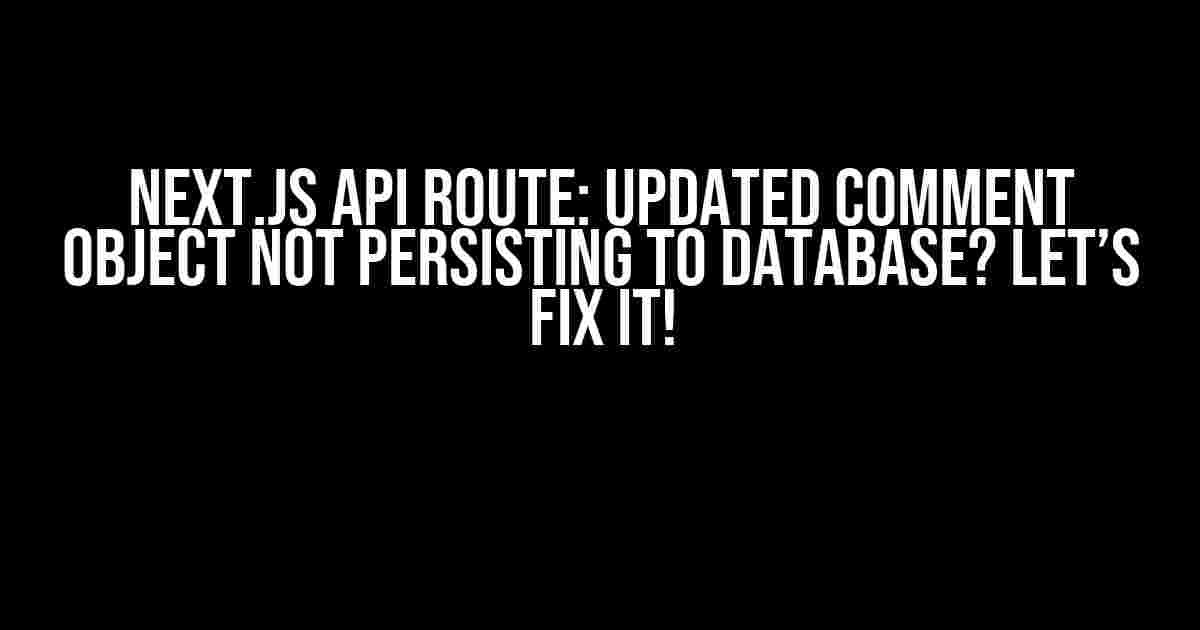Are you stuck in the trenches of Next.js development, wondering why your beautifully crafted API route isn’t persisting that updated comment object to the database? Don’t worry, friend, you’re not alone! In this comprehensive guide, we’ll dive into the world of Next.js API routes, explore common pitfalls, and provide a step-by-step solution to get your comment object updating like a charm.
The Problem: Updated Comment Object Not Persisting
Let’s set the stage. You’ve created a Next.js API route to handle comment updates. The route receives the updated comment object, performs some magic, and then… crickets. The updated comment object doesn’t make it to the database. You’ve checked the console, the network requests, and even the API route itself, but nothing seems to be amiss. Sound familiar?
Possible Causes
Before we dive into the solution, let’s quickly explore some common culprits behind this issue:
- Incorrect API Route Configuration: Are you using the correct HTTP method (e.g., PATCH, PUT)? Is your API route correctly configured to handle the request?
- Middleware Mayhem: Are you using middleware that’s interfering with the request or response?
- Data Serialization: Are you serializing the comment object correctly before sending it to the database?
- Database Connection Issues: Is your database connection properly established, and are you using the correct database instance?
- Async/Await Woes: Are you handling asynchronous operations correctly in your API route?
The Solution: Step-by-Step Guide
Now that we’ve explored the potential causes, let’s walk through a step-by-step solution to get that updated comment object persisting to the database:
Step 1: Verify API Route Configuration
Double-check your API route configuration to ensure you’re using the correct HTTP method and route path. For example:
import { NextApiRequest, NextApiResponse } from 'next';
const updateComment = async (req: NextApiRequest, res: NextApiResponse) => {
// ...
};
export default updateComment;
In this example, we’re using a `updateComment` API route that handles an asynchronous request.
Step 2: Use Middleware Wisely
Review your middleware usage to ensure it’s not interfering with the request or response. If you’re using middleware, make sure it’s properly configured and not blocking the request:
import { NextApiRequest, NextApiResponse } from 'next';
import withMiddleware from '../middleware/withMiddleware';
const updateComment = async (req: NextApiRequest, res: NextApiResponse) => {
// ...
};
export default withMiddleware(updateComment);
In this example, we’re using a `withMiddleware` function to wrap our `updateComment` API route. This ensures that the middleware is properly applied without blocking the request.
Step 3: Serialize the Comment Object
Serialize the updated comment object before sending it to the database. You can use a library like `json-stringify-safe` to ensure safe serialization:
import { stringify } from 'json-stringify-safe';
const updatedComment = { /* updated comment object */ };
const serializedComment = stringify(updatedComment);
// Send serializedComment to the database
In this example, we’re using `json-stringify-safe` to serialize the updated comment object before sending it to the database.
Step 4: Establish a Proper Database Connection
Verify that your database connection is properly established and you’re using the correct database instance. Make sure you’re using the correct database credentials and instance:
import { MongoClient } from 'mongodb';
const client = new MongoClient('mongodb://localhost:27017/', { useNewUrlParser: true, useUnifiedTopology: true });
const db = client.db();
// Use the db instance to interact with your database
In this example, we’re using the `MongoClient` from the `mongodb` package to establish a connection to our local MongoDB instance.
Step 5: Handle Asynchronous Operations
Ensure you’re handling asynchronous operations correctly in your API route. Use `async/await` or `.then()` to properly handle promises:
const updateComment = async (req: NextApiRequest, res: NextApiResponse) => {
try {
const updatedComment = await updateCommentInDatabase(serializedComment);
res.status(200).json({ message: 'Comment updated successfully' });
} catch (error) {
console.error(error);
res.status(500).json({ message: 'Error updating comment' });
}
};
In this example, we’re using `async/await` to handle the asynchronous operation of updating the comment in the database. We’re also using a `try-catch` block to handle any errors that may occur.
Conclusion
And there you have it! By following these steps, you should be able to persist that updated comment object to your database. Remember to double-check your API route configuration, middleware usage, data serialization, database connection, and asynchronous operation handling.
Common Pitfalls to Avoid
Before we part ways, here are some common pitfalls to avoid when dealing with Next.js API routes and database interactions:
- Not using the correct HTTP method or route path
- Not serializing data correctly before sending it to the database
- Not handling asynchronous operations correctly
- Not using the correct database instance or credentials
- Not properly configuring middleware or using it incorrectly
Bonus: Debugging Tips
To help you debug your Next.js API route, here are some bonus tips:
- Use the Network Tab in DevTools: Inspect the network request and response to ensure the data is being sent correctly.
- Console Log Everything: Log each step of your API route to identify where the issue is occurring.
- Use a Debugger: Use a debugger like Visual Studio Code or Chrome DevTools to step through your code and identify the issue.
- Check the Database Logs: Verify that the database is receiving the updated comment object and check for any errors in the database logs.
Final Thoughts
In conclusion, updating a comment object in a Next.js API route and persisting it to the database can be a complex process. However, by following this comprehensive guide, you should be able to overcome the common pitfalls and get your comment object updated and saved to the database.
| Keyword | Explanation |
|---|---|
| Next.js API Route | A server-side API route in a Next.js application |
| Updated Comment Object | A comment object that has been modified and needs to be persisted to the database |
| Persisting to Database | The process of saving data to a database |
Remember to bookmark this article for future reference and share it with your fellow developers who may be struggling with this issue. Happy coding!
Here are 5 Questions and Answers about “Next.js API Route: Updated Comment Object Not Persisting to Database”:
Frequently Asked Question
Having trouble with updating comments in your Next.js API route? Don’t worry, we’ve got you covered!
Why is my updated comment object not persisting to the database?
This might be due to the fact that you’re not sending the updated comment object to the database. Make sure you’re using the correct method to update the comment, such as PUT or PATCH, and that you’re sending the updated data in the request body.
Is there a specific way to update a comment object in a Next.js API route?
Yes, you should use a mutation function to update the comment object. This function should update the comment object in the database and return the updated object. You can use a library like Prisma to interact with your database.
What if I’m using a state management library like Redux or MobX?
If you’re using a state management library, make sure you’re updating the state correctly and then sending the updated state to the database. You might need to use a middleware or an action creator to update the state and then send it to the database.
Can I use a library like Axios to make the API request to update the comment?
Yes, you can use a library like Axios to make the API request to update the comment. However, make sure you’re handling errors correctly and that you’re sending the correct data in the request body.
What if I’m still having trouble updating the comment object?
If you’re still having trouble, try debugging your code to see where the issue is. Check the network requests to make sure the correct data is being sent to the API, and check the API logs to make sure the data is being received correctly. You can also try using a tool like Postman to test the API endpoint directly.


